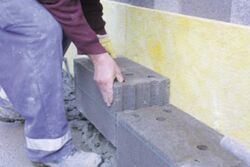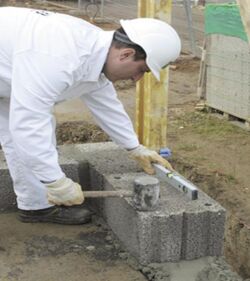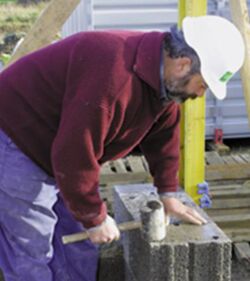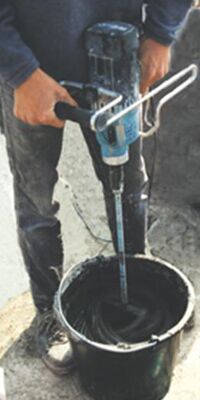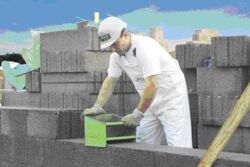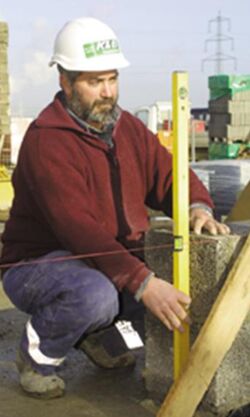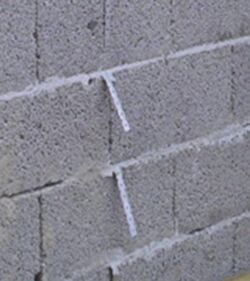Processing of KLB flat blocks
Notes for fast and economical processing
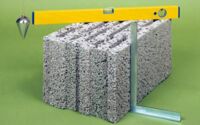
KLB flat block masonry is the logical consequence of the increasingly precise KLB manufacturing methods, which allow the manufacture of plane-parallel 12.4 cm or 24.9 cm high blocks. In conjunction with a thin-bed mortar layer of only 1 mm a height guide dimension of 12.5 cm or 25.0 cm can be maintained this way. All blocks of the KLB flat block program are manufactured in the manufacturing plant so precisely or ground on the side of the standing surface such that the height tolerances of the blocks are at a maximum ± 1 mm.
The different normal-format flat blocks are supplemented by small-format KLB solid blocks, which also are only processed with thin-bed mortar. Butt blocks or bay blocks do not have to be omitted with the KLB flat block range. Every block of this range is built according to the octametric system and manufactured plane-parallel.
The KLB flat blocks are processed with the KLB thin-bed mortar specially developed and adapted for these blocks. The mortaring with KLB thin-bed mortar has a number of decisive advantages compared to traditional mortars, such as:
- fast and economical processing
- lower mortar demand than with normal mortar spread
- strengths like those for masonry with normal mortar of mortar group MG III
- no thermal or sound bridges
- quality-controlled ready-mix dry mortar with consistent quality
- joint delivery of the mortar with the flat blocks
The thin-bed mortar layer is spread uniformly over the entire length of the first block layer using a thin-bed mortar sledge. The first layer must be bricked up beforehand in thin-bed mortar vertically and horizontally. Then the block shaped KLB flat blocks are placed narrowly in rows, tight against each other - butt joint interlock in butt joint interlock - onto the thin-bed mortar bed. The slots or chambers of the blocks are on the bottom during placement and thereby lock in the thermally insulating air in the hollow spaces. The blocks are not meant to be slid on the thin-bed mortar into the interlock but are to glide down into the interlock from above. The butt joint area of the large format blocks equipped with tongue and groove labyrinth interlocking remains without mortar.
The large-format blocks have diagonally set thumb holes for easier handling when processing manually, and recesses on both sides in the direction of the block axis in the butt joint area to also be able to place them by machine; several blocks can be set simultaneously in one work step that way. The small-format solid blocks are processed as individual blocks and are covered with a thin-bed mortar spread on the horizontal and butt joint with a toothed trowel. The butt joint must also be "glued" when preparing cut blocks or when butt-joining with thin-bed mortar.
The following short texts and pictures show the process in detail.
For perpendicular and horizontal alignment of the 1st layer in the mortar bed and processing of the bricks in the thin-bed method, a rubber mallet and spirit level are permanent tools for masonry work.
Precise measuring (height levelling), alignment and exact placement of the blocks from corner to corner saves later grief.
Placement of the bottom-most layer (offset layer) occurs on a thick-bed mortar bed made of light-weight or normal mortar according to the building physics and static requirements. The orientation requires the corners to placed according to the plan specification. Door openings, wall connections etc. should also be marked in advance on the floor and ceiling panel.
For easier handling during manual processing the large format KLB blocks have diagonally placed handholes and for processing using the mini crane (2 - 4 blocks in one work step) offset grooves.
The mortar-free butt joints allow fast placement of the blocks. KLB flat blocks are lined up next to each other without mortar. Here the blocks are placed from above, gliding into the tongue and groove formation of the already placed block, down onto the mortar bed.
Mixing is done using a mixer with a whisk attachment. After the 1st layer is set all around, the actual flat block processing with the thin-bed mortar that guarantees fast construction progress starts. The thin-bed mortar that was delivered as ready-made dry mortar is stirred according to the manufacturer’s information (bag label and processing notes).
For spreading the KLB thin-bed mortar a KLB mortar sledge for the respective wall thickness is used. The tooth edge is specifically coordinated for the mortar and the thickness of the mortar spread for the masonry.
After fast three or four layers, the parapet height for the windows has generally been reached. With the dividable end blocks located in each block location the smooth reveal or outside corners are built.
For the butt joint technology in the area of the planned, outbound interior walls flat steel anchors must be inserted on the exterior walls being erected according to static requirements. The anchors are bent down or up for protection against injuries as long as the interior walls are not bricked up.



